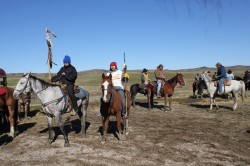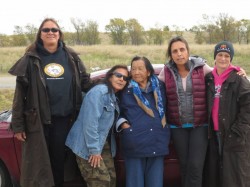News | March 6th, 2014

“No Keystone XL Black Snake Pipeline will cross Lakota Lands. We will protect our lands and waters and we have our horses ready…” Bryan Brewer, President of the Oglala Sioux Tribe
In mid February, the Keystone XL Pipeline, or the Black Snake found some stronger adversaries. “It poses a threat to our sacred water and the product is coming from the tar sands and our tribes oppose the tar sands mining,” Debra White Plume, an Oglala leader, told the press.
White Plume’s family and many others have opposed the pipeline, along with a myriad of uranium mining projects proposed for the Paha Sapa, the Black Hills. “All of our tribes have taken action to oppose the Keystone XL pipeline. Members from the seven tribes of the Lakota Nation, along with tribal members and tribes in Idaho, Oklahoma, Montana, Nebraska and Oregon, are prepared to stop construction of the pipeline.”
This past October , the Lakota rode some of the proposed pipeline route in a set of three rides organized by grassroots and national organizations, including Honor the Earth, Owe Aku and 350.org. The routes covered territory between Wanbli on the Pine Ridge reservation to Takini on the Cheyenne River reservation, in a spiritual ride to honor the water and counter the oil. This ride was one of three rides (the other two were Minnesota pipeline rides on the Alberta Clipper and proposed Sandpiper route for fracked oil. See video link at http://tiny.cc/z8r3bx).
The Lakota will ride again. That is if the pipeline project get’s President Obama’s approval. And that is, if the Nebraska and Iowa lawmakers, don’t stop it first, because of the little constitutional problems of eminent domain. And, that is also if the Environmental Protection Agency, doesn’t close it down.
The Keystone XL Project took a big step forward for oil companies, when the State Department announced that the pipeline had passed the most recent environmental review. (The State Department Inspector General however, is investigating potential conflicts of interest on the part of ERM, the contractor hired to conduct the study, because of close relations with TransCanada, the pipeline company, in the past.)
All in all there is a lot of confusion. At a national level, in theory, the project will now go into a final phase which focuses on whether Keystone XL “serves the national interest.” Pipeline’s environmental, cultural and economic impacts will be weighed in this phase and at least eight agencies will have input on the outcome, including the Departments of Defense, Justice, Interior, Commerce, Transportation, Energy and Homeland Security and the Environmental Protection Agency. And then there are the tribes.
The l868 Fort Laramie Treaty is the treaty between the US and the Lakota Nation. Oceti Sakowin treaty territory is overlapped by Montana, North Dakota, South Dakota, and Nebraska. These lands and that treaty are sacred to the Lakota, and, across Indian country, tribal leaders and non Indians are demanding that those treaties be recognized as the law of the land, since they are Article Two of the US constitution.

At the mid February summit of the Lakota, and their allies, reaffirmed opposition to the Black Snake. Gary Dorr, from the Nez Perce Tribe in Idaho, talked about opposition to the pipeline, and his tribe’s legal position on the tar sands. The Nez Perce tribe has already used its treaty rights to block the transport of so-called megaloads of mining equipment headed to Alberta’s tar sands through its territory. The tribe launched blockades and won a court battle to stop the shipments from traversing its lands. “It will be obvious, it will be concrete, and I think once it starts and they start building you will start to see the momentum and the force of the tribal people … It is an epic project, it will have an epic response from the tribal people,” said Dorr. “The tar sands is already affecting the people [for Fort Chipewyan in Alberta], climate change is already obvious. To facilitate that is not something the Native people of the U.S. are going to do. We are not going to sit idly by and let it happen.”
Among the voices at the conference were treaty council representatives Faith Spotted Eagle of Yankton Russell Eagle Bear of Rosebud, Jay Taken Alive of Standing Rock, Leonard Little Finger of Oglala Treaty Council and other traditional chiefs and leaders. They reminded participants of the Mother Earth Accord that indigenous leaders and allies signed at Rosebud in 2011 and the International Treaty to Protect the Sacred from the Tar Sands Project they signed at Yankton in 2013. They also stressed their willingness to resort to direct action if Obama approves the pipeline.
The administration’s decision on whether to approve a Presidential Permit for the Keystone XL Pipeline will be based on whether the proposal is “in the national interest.” Robert Gough , secretary of the Intertribal Council On Utility Policy, asked, “Whose national interest is at stake?” He answered, “No place more than here,” referring to the Lakota nation and the region.
“The pipeline would carry bitumen diluted in toxic slurry (dilbit) across the route of the rural water pipeline that provides drinking water supplies on the reservations in South Dakota, as well as across the Cheyenne River, and across the Ogallala Aquifer, Gough said. “TransCanada’s first dilbit line spilled 14 times in its first year of operations after receiving a Presidential Permit to pass from Alberta across North Dakota, South Dakota, Nebraska, Iowa and Illinois. Even if it wasn’t spilled, it’s a death knell for the planet we as humans have lived on for thousands and thousands and thousands of years,” Gough said, referring to the carbon impact of the tar sands themselves.
TransCanada countered, “The incorporation of 59 special conditions and dozens of other extra spill prevention and mitigation measures will ensure that Keystone XL will have a degree of safety over any other typically constructed domestic oil pipeline system under current code.”
That might hold up in TransCanada’s mind, but, leaks are continually reported on the present oil pipelines. And, it appears 20 percent of pipeline spills are found by the companies, the remainder found by people who are not equipped to stop spills. Besides that, the Lakota point out that the Oglalla aquifer is the sole drinking water source for not only humans but everything else. There is no way a people who have lived in this area for a thousand years are going to accept the word of a 50-year-old pipeline company.

Percy White Plume, leader of both the Big Foot Memorial Ride and this past fall’s ride on the Keystone XL pipeline asks, “If our children and grandchildren have no water and have to drink bottled water because of the contamination of the pipeline, or a leak, what will our horses be able to drink. What will the wildlife drink?”
And then there’s the Environmental Protection Agency. It appears the agency just woke up to a legal responsibility and seeming to be taking it seriously. In 2013 Bob Perciasepe, deputy administrator of the EPA, wrote to all regional administrators: “… Treaties are the law, equal in statutes to federal laws under the U.S. constitution, and … the US has the responsibility to honor the rights and resources protected by the treaties. While treaties do not expand the authorities granted by the EPA’s underlying statutes, our programs should be implemented to protect treaty covered resources where we have the discretion to do so.”
It would appear that the EPA has a broader obligation scope than it has been taking, with the EIS process for the Keystone XL. And, that treaty protection scope might consider the pipeline. This is true, since the EPA might have found its mojo again.
This is how we know the mojo might have been found: The last week of February, the EPA took action to consider the impact of the proposed Pebble Mine project on the Bristol Bay fishery in Alaska. It’s a very controversial project. That fishery provides about a third of the sockeye salmon to the U.S. consumer, and would be destroyed by the proposed mine. The EPA, after l50,000 comments, decided to intervene.
Back in the northern plains, there’s a similar discussion about what people will drink, not just what they will eat. The Bakken oil field extraction is already contaminating water supplies in a state with little water. And, it turns out that people may not want to drink Kool-Aid.
That’s a term that came from the Reverend Jim Jones, I believe, and it is something you don’t want to do. His Kool-Aid killed around 900 people, his ardent followers. There is a new Kool-Aid, some would say. The TransCanada/Koch Brothers Enbridge/SynCrude Kool-Aid, says there are a lot of jobs in the pipelines, that the U.S. economy will be saved, and we’ll all be more secure with the pipeline.
This is not actually true. It turns out that mega projects are not employment opportunities. I’d say the last mega projects that really were employment opportunities were the building of the Egyptian pyramids by Jewish slave labor. This might be a little different, but a lot of people don’t like being a slave to the Egyptians or to the oil companies.
Let’s think about what $7 billion in investments could buy if we thought about the economy and energy of this country. A just released study analyzing employment from the Keystone XL proposal, versus needs and employment for other options found some rather large holes in industry claims. The study found that spending money on unmet water and gas infrastructure needs in the five relevant states along the KXL pipeline route will create more than 300,000 total jobs across all sectors, or five times more jobs than the KXL, with 95 times more long term jobs.
Think of it this way: The American Society of Civil Engineers, in its latest infrastructure report card, gave the country a D in drinking water and waste water infrastructure and a D+ in energy infrastructure. Infrastructure failure is causing gas explosions and water main ruptures around the country. Infrastructure failure is when your I-35 Bridge collapses in Minneapolis, and infrastructure failure is when an ExxonMobil pipeline ruptures in Mayflower, Ark., spilling 7,000 barrels of oil into a suburb.. We have an infrastructure problem generally in the country. Some folks would say we should fix old pipelines before we make new ones, particularly pipelines that don’t serve our towns, cities or homes.
And then there is tribal infrastructure. About 14 percent of reservation households are without electricity, 10 times the national rate. Energy distribution systems on rural reservations are extremely vulnerable to extended power outages during winter storms, threatening the lives of reservation residents. Reservation communities are at a statistically greater risk from extreme weather-related mortality nationwide, especially from cold, heat and drought associated with a rapidly changing climate. For instance, Debbie Dogskin, a Lakota woman on the Standing Rock reservation, froze to death in February, when she couldn’t pay her skyrocketing propane bills. Her propane ran out. Ironically, she lived about a hundred miles from the Bakken oil fields where they flare off gas, they‘ve got so much.
Reservations need more than 200,000 new houses, and there is no money for them. And then there is the special case of Pine Ridge, the largest Lakota reservation, and the poster child of those who want to talk about how horrible the conditions of Native people are. At Pine Ridge, the reservation where Bryan Brewer, Debra White Plume, Percy White Plume live, no one believes in the white man’s pipeline. They call it the fat takers’ pipeline, the pipeline of the wasichu. At Pine Ridge 97 percent of the people live below federal poverty line. The unemployment rate vacillates from 85 to 95 percent on the reservation. At least 60 percent of the homes are severely substandard, without water, electricity, adequate insulation, and sewage systems.
Basically, the Lakota, like many other Native people see a big infrastructure project like the KXL pipeline, which moves profits from one corporation to another, across their land, as more than a black snake of the fat taker. It is a threat, and there is no new water.
Finally, there is that pesky problem of the constitution. It’s a problem with Indian treaties, and it is a problem with the Keystone XL Pipeline, largely because, it seems that in Nebraska the governor was just too excited about approving the pipeline, and violated the constitutional rights of Nebraska citizens.
The eminent domain questions have been ongoing, and challenging, but in February, Nebraska district judge Stephanie Stacy declared unconstitutional a law that had given Nebraska Gov. Dave Heineman the power to push the project through private land.
This past week, two Iowa state legislators, Sen. Rob Hogg and Rep. Bobby Kaufmann called on Congress to oppose the proposed Keystone XL pipeline because of the use of eminent domain in the development of the project. “I urge you to stand with those landowners who do not want this pipeline running through their property,” wrote Rep. Kaufmann in a letter to Congressman Dave Loebsack of Iowa’s Second Congressional District. “The interests in oil profits should not supersede the rights of property owners.”
“It is not in America’s national interests to allow a foreign oil company to condemn American farms and ranches to take foreign oil to the Gulf Coast for sale on the global market,” wrote Sen. Hogg in a letter to Congressman Bruce Braley of Iowa’s First Congressional District. “The Keystone pipeline threatens America’s land, water, and wildlife – Congress should say no, the State Department should say no, and President Obama should say no.”
This past spring a gathering of ranchers and Natives came together, forming what is called the Cowboy and Indian Alliance, representing Nebraska and South Dakota ranchers and Lakota, Ponca and other Native people. They, too, are intent upon stopping the pipeline. So there you go: he Fat Takers Pipeline the Wasichu Black Snake is facing new adversaries, and they are daunting, they are tough, and they are your neighbors.
December 16th 2025
November 14th 2025
October 13th 2025
October 13th 2025
October 6th 2025
_(1)__293px-wide.png)
__293px-wide.jpg)
__293px-wide.jpg)
_(1)_(1)_(1)__293px-wide.jpg)
_(1)__293px-wide.jpg)
